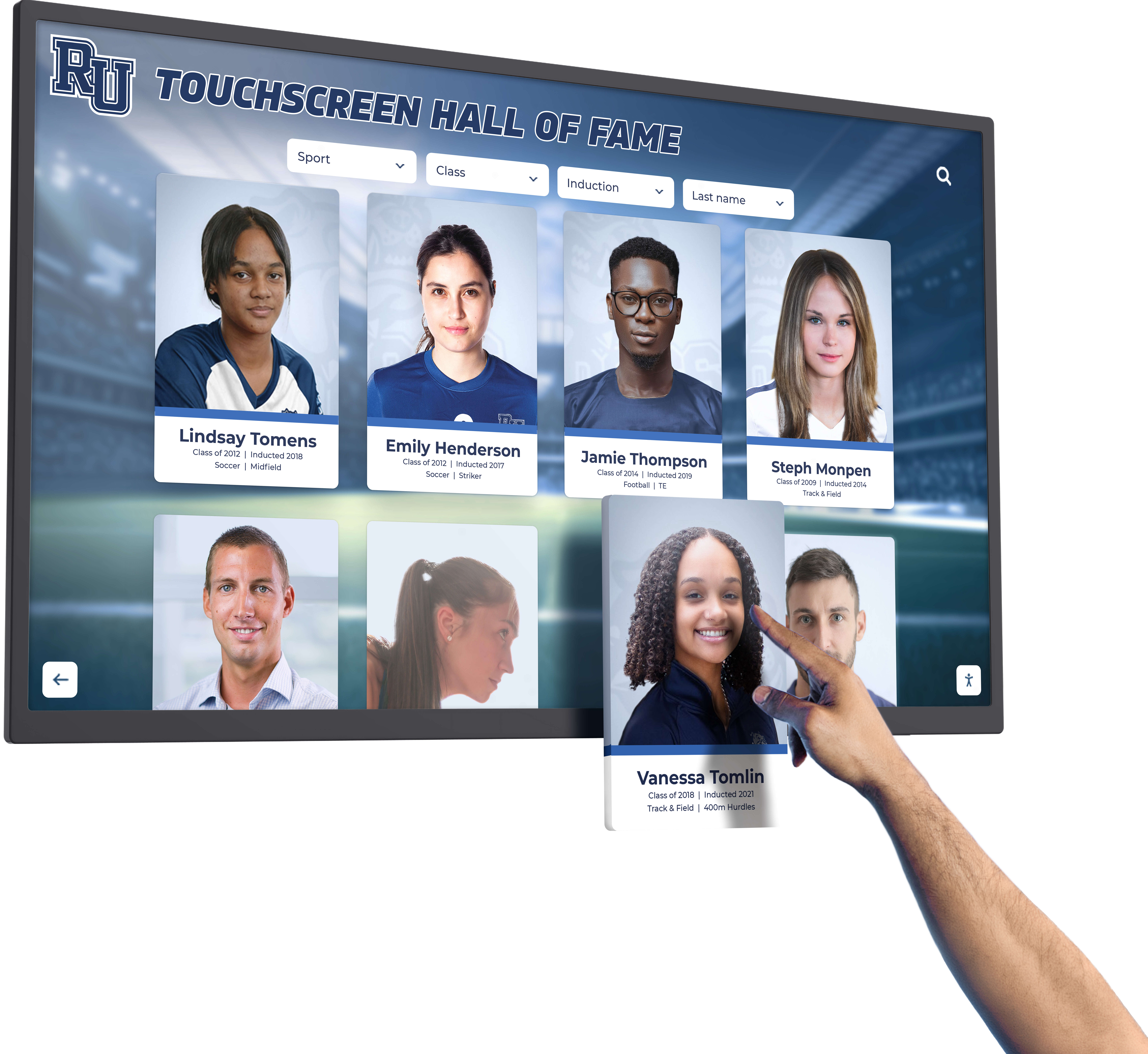Key Takeaways
Expert guide comparing digital signage options for schools. Evaluate features, costs, and platforms including recognition displays, communication systems, and interactive solutions.
Understanding Your School’s Digital Signage Needs
Before comparing specific solutions, clarifying your school’s primary objectives and use cases provides the foundation for informed decision-making.
Defining Clear Objectives and Use Cases
Different digital signage applications serve fundamentally different purposes within educational environments. Understanding these distinctions prevents the common mistake of selecting generic solutions that fail to excel at any particular function.
Recognition and Culture Building: Many schools prioritize celebrating student achievement, building school pride, and honoring alumni through interactive displays in hallways, lobbies, and common areas. These applications demand searchable databases, multimedia storytelling capabilities, easy content management for non-technical staff, and engaging interfaces that invite exploration rather than passive viewing.
Daily Communication and Announcements: Other schools focus on sharing daily information, schedule changes, event promotions, and cafeteria menus throughout facilities. These applications emphasize scheduled content rotation, real-time updates, simple content creation, and broad network management across multiple displays.
Emergency Notifications: Safety-focused implementations integrate with alert systems to display critical information during emergencies, overriding scheduled content automatically. This requires reliable system integration, guaranteed uptime, and instant campus-wide messaging capabilities.
Wayfinding and Directories: Large campuses benefit from digital directories helping visitors locate specific offices, classrooms, or facilities. These applications need intuitive navigation interfaces, interactive maps, and regular database updates.
Most schools ultimately implement multiple digital signage use cases, but identifying the primary driver helps narrow options to platforms excelling in relevant capabilities rather than settling for mediocre generalists.

Assessing Budget Realities and Total Cost of Ownership
Digital signage costs extend far beyond initial hardware purchases. Comprehensive budget assessment considers all expense categories over expected system lifespans.
Hardware Costs: Display panels ranging from 43 to 86 inches typically cost $400-$4,000 depending on size, commercial-grade quality, and touch capabilities. Mounting equipment, protective enclosures, and media players add $200-$1,000 per installation. Professional installation labor contributes $300-$1,500 per display depending on complexity and infrastructure requirements.
Software and Licensing: Cloud-based content management platforms typically charge $10-$50 per display monthly for basic communication solutions. Purpose-built recognition systems range $100-$300 per display monthly due to specialized features and robust capabilities. Annual software costs often represent 10-20% of initial investment.
Infrastructure: Network upgrades ensuring adequate bandwidth, WiFi coverage improvements, and electrical work meeting display power requirements add $500-$3,000 per location depending on existing infrastructure adequacy.
Ongoing Expenses: Electricity consumption (typically $30-$60 annually per display), maintenance reserves (budget 5-10% of hardware cost), technical support contracts, and staff time for content management accumulate throughout system lifespans.
Replacement Cycles: Commercial-grade displays last 7-10 years with 50,000+ operating hours. Consumer-grade equipment fails prematurely, requiring expensive replacements eliminating apparent initial savings.
Calculate five-year total cost of ownership rather than focusing exclusively on initial purchase prices. The cheapest option today often becomes the most expensive over time when premature replacements, inadequate capabilities, and poor support multiply costs.
Comparing Digital Signage Platform Categories
Digital signage solutions fall into distinct categories, each optimized for particular applications and use cases. Understanding these categories helps schools identify appropriate options rather than comparing incompatible systems.
Purpose-Built Educational Recognition Platforms
Specialized platforms designed specifically for celebrating achievement and building school culture deliver capabilities generic signage cannot match.
Rocket Alumni Solutions: As the leading educational recognition platform, Rocket specializes exclusively in helping schools honor students, athletes, and alumni through interactive touchscreen displays and companion mobile applications. Unlike generic signage adapted for schools, every feature reflects deep understanding of how educational institutions operate and what communities value.
Key capabilities include unlimited recognition capacity transcending physical trophy case limitations, searchable interactive experiences letting visitors explore by name, year, sport, or achievement category, multimedia storytelling incorporating photos, videos, statistics, and biographical narratives, intuitive content management requiring no technical expertise from school staff, mobile companion apps extending access globally beyond physical installations, and white-glove implementation support including content migration, design customization, and ongoing technical assistance.
Recognition-focused displays excel at building school pride, engaging alumni, showcasing comprehensive achievement across academics, athletics, arts, and service, and creating memorable experiences that static displays cannot deliver. Schools implementing digital recognition report ability to honor every deserving student rather than limiting recognition to those fitting predetermined physical display constraints. For comprehensive guidance on building school culture through recognition displays, explore strategies that strengthen community identity.

General-Purpose School Communication Platforms
Platforms designed for daily communication, announcements, and information sharing across school facilities serve different needs than recognition systems.
Cleardigital with SHO Software: Cleardigital provides robust communication-focused signage with intuitive SHO content management software designed specifically for educational institutions. Strong integration with emergency notification systems including CENTEGIX, Singlewire InformaCast, and Raptor Technologies enables instant safety alerts campus-wide. User-friendly content creation tools, real-time data connections to Google Sheets, and Canva integration support diverse communication needs without requiring technical expertise.
ScreenCloud: Cloud-based platform supporting various display use cases from announcements to digital menu boards. Strengths include broad app marketplace, intuitive interface, and flexible content scheduling. Works well for universities with decentralized content management across multiple departments.
Wallboard: Positions itself as comprehensive communication hub rather than simple signage platform. Emphasizes district-level management with central control over distributed displays while enabling localized content management. Appeals to larger districts seeking consistency across multiple campuses.
These platforms excel at rotating announcements, event promotions, schedule displays, menu boards, and general information sharing. They integrate with various data sources and typically offer lower entry costs than specialized recognition systems while delivering less depth in any single application area.
Budget-Friendly Generic Signage Solutions
Cost-conscious schools sometimes consider consumer-grade or minimal-feature options to stretch limited technology budgets.
Yodeck: Built around affordable Raspberry Pi hardware, Yodeck offers compelling economics with free single-display options and low monthly fees for additional screens. Credit card-sized media players cost $100-$150, dramatically less than commercial alternatives. Reliable performance despite budget pricing makes Yodeck attractive for schools testing digital signage viability before broader investments.
However, Yodeck delivers basic slideshow functionality without specialized educational features, advanced interactivity, or purpose-built recognition capabilities. It works adequately for rotating announcements but cannot support comprehensive achievement databases, searchable content, or sophisticated user experiences.
Rise Vision: Education-focused platform offering budget-friendly pricing and school-oriented templates. While targeting educational markets specifically, Rise Vision’s capabilities and user experience trail leading providers significantly. Platform interfaces feel dated compared to modern alternatives, with limited advanced features and narrower device compatibility.
For schools with very basic slideshow needs and minimal budgets, Rise Vision functions adequately. Institutions seeking professional presentation quality, advanced features, or exceptional user experiences should explore more capable alternatives.
Google Slides: The most minimal option involves displaying Google Slides presentations on screens throughout facilities. With zero additional software cost beyond Google Workspace for Education, this represents absolute budget basement approach.
Severe limitations include no proper content management, scheduling, or remote control capabilities true signage platforms provide. Displays must remain logged into Google accounts with browsers open continuously—impractical for unattended public installations. No interactive capabilities, professional features, or emergency notification integration. Google Slides represents workaround rather than actual digital signage solution, suitable only for extremely limited classroom applications rather than school-wide implementations.

Key Features to Compare Across Platforms
When evaluating digital signage options, specific feature categories significantly impact long-term satisfaction and value.
Content Management and Ease of Use
The interface school staff uses daily to create, schedule, and manage content determines whether systems remain current and valuable or become neglected installations generating brief initial enthusiasm before falling into disuse.
User-Friendly Interfaces: Platforms requiring extensive technical expertise limit content management to already-overburdened IT staff, creating bottlenecks that prevent timely updates. The best solutions enable teachers, administrators, and support staff to manage content confidently through intuitive drag-and-drop interfaces, template-based layouts, and straightforward workflows requiring minimal training.
Bulk Upload Capabilities: Schools often need to add hundreds of historical records, team rosters, or achievement entries simultaneously. Robust bulk upload features supporting CSV files, batch photo processing, and automated data structuring save countless hours compared to manual individual entry.
Remote Access: Cloud-based management enabling authorized staff to update content from any device, anywhere proves essential for convenience and flexibility. On-premise systems requiring physical access to specific computers create unnecessary constraints.
Multi-User Access: Multiple staff members should manage content simultaneously with appropriate permission levels controlling who can create, edit, approve, and publish materials. Single-user limitations create bottlenecks and single points of failure when key personnel are unavailable.
Scheduling and Automation: Advanced scheduling lets administrators prepare content days or weeks ahead, automatically publish at appropriate times, and rotate materials without manual intervention. Seasonal content, event promotions, and time-sensitive information benefit tremendously from robust scheduling capabilities.
Interactive Capabilities and User Experience
Interactive touchscreen displays transform passive information consumption into engaging exploration experiences creating memorable connections with content.
Touch Responsiveness: Modern displays should respond to touch input within 10 milliseconds. Noticeable lag creates frustrating user experiences undermining confidence in technology. Test response time during evaluation rather than relying solely on manufacturer specifications.
Search and Filtering: Recognition applications particularly benefit from robust search enabling visitors to find specific individuals by name, browse achievements by category or year, and discover related content through intelligent recommendations. Generic signage platforms typically lack sophisticated search capabilities purpose-built systems provide.
Navigation Intuition: Touch interfaces should feel intuitive to users of all ages and technical comfort levels. Confusing navigation reduces engagement and frustrates visitors. Observe actual users interacting with demo systems during evaluation to assess real-world usability rather than accepting vendor demonstrations designed to showcase features optimally.
Multimedia Integration: Rich content experiences incorporate high-resolution photos, video highlights, document archives, and dynamic statistics. Platform media handling capabilities, supported file formats, and storage capacity significantly impact presentation quality and content depth schools can provide.

Hardware Compatibility and Flexibility
Understanding what display hardware works with different software platforms impacts both initial costs and long-term flexibility.
Display Requirements: Some platforms work with any commercial display connected to compatible media players, offering hardware flexibility and enabling schools to select displays matching specific needs and budgets. Other solutions require proprietary hardware, limiting options but potentially simplifying implementation and support.
Media Player Options: Generic platforms often support diverse media players including Windows computers, Android devices, Raspberry Pi units, BrightSign players, and more. This flexibility enables cost optimization and hardware standardization with existing infrastructure. Specialized platforms may include integrated computing or require specific player models ensuring compatibility and performance. Schools evaluating digital wall of fame solutions should consider both hardware flexibility and specialized capabilities.
Touch Capability Requirements: Recognition and wayfinding applications demand touchscreen capabilities, while announcement displays function with standard non-touch panels. Understanding whether platforms require touch-enabled hardware versus supporting it optionally impacts hardware budgets significantly—touchscreens typically cost 50-100% more than equivalent non-touch displays.
Scalability: Solutions should accommodate growth from single pilot installations to comprehensive networks spanning multiple buildings and campuses. Centralized management interfaces controlling distributed displays, consistent content standards across installations, and administrative hierarchies supporting multi-campus organizations prove essential for districts planning expansions over time.
Integration with Existing School Systems
Digital signage doesn’t exist in isolation. Integration with other technology systems enhances value while reducing administrative burden.
Emergency Notification Systems: Safety-focused implementations must integrate seamlessly with emergency alert platforms used throughout districts. Leading signage solutions connect with CENTEGIX, Singlewire InformaCast, Intrado Revolution, Raptor Technologies, and other notification systems to display critical alerts instantly, overriding scheduled content automatically during emergencies.
Student Information Systems: Recognition platforms benefit from connecting with student databases, enabling automatic synchronization of enrollment data, achievement records, and biographical information. This integration reduces duplicate data entry and ensures accuracy across systems.
Calendar and Scheduling Systems: Displaying event information, room schedules, and activity calendars becomes simpler when signage platforms connect with Google Calendar, Microsoft Outlook, or dedicated school calendaring systems. Automatic synchronization ensures displayed information remains current without manual updates.
Social Media Integration: Some platforms enable content creation from or sharing to social media platforms, extending signage reach beyond physical installations. Schools active on Facebook, Twitter, Instagram, or other platforms may value this connectivity for consistent multi-channel communication. Discover how interactive displays create engaging experiences that students actually love.
Comparing Costs: Understanding What You’re Actually Paying For
Digital signage pricing varies dramatically across solutions, but understanding what drives costs helps schools evaluate value rather than simply seeking lowest prices.
Hardware Investment Analysis
Entry-Level Non-Touch Displays: Commercial-grade 43-55 inch displays suitable for announcement and communication applications cost $400-$1,200. Add $150-$300 for basic media players (Raspberry Pi, basic Android boxes, or entry Windows computers) plus $200-$500 for mounting and installation. Total per-display costs typically range $750-$2,000 for basic communication applications.
Mid-Range Touch-Enabled Displays: Interactive 55-65 inch touchscreens suitable for engagement and recognition applications cost $1,500-$3,500. Include $300-$600 for more capable media players handling interactive performance demands, plus $300-$800 for more substantial mounting and installation. Complete installations typically range $2,100-$4,900 per display.
Premium Large-Format Installations: High-impact 75-86 inch touchscreens creating flagship recognition experiences cost $3,500-$7,000. Professional media players or integrated computing add $500-$1,200, with installation and electrical work contributing $500-$1,500. Premium installations range $4,500-$9,700 per display.
Infrastructure Requirements: Budget additional funds for network improvements ($500-$2,000 per location), electrical upgrades ($300-$1,500), and protective enclosures if needed ($200-$800). Schools with adequate infrastructure save significantly versus those requiring extensive facility work.

Software and Service Costs
Budget Generic Platforms: Basic communication platforms like Yodeck charge $8-$15 per display monthly. Annual costs of $96-$180 per display seem affordable initially but deliver only basic capabilities without advanced features, professional support, or educational specialization.
Mid-Tier Communication Platforms: Platforms like Cleardigital, ScreenCloud, and similar offerings charge $15-$40 per display monthly ($180-$480 annually), reflecting enhanced capabilities, better support, and more robust features compared to budget options.
Specialized Recognition Platforms: Purpose-built systems like Rocket Alumni Solutions typically charge $100-$300 per display monthly ($1,200-$3,600 annually), reflecting specialized capabilities, comprehensive content management, interactive features, mobile applications, and white-glove implementation support generic platforms don’t provide.
Higher software costs reflect genuine value differences. Purpose-built recognition platforms deliver capabilities impossible with generic signage—searchable databases, sophisticated user experiences, professional presentation quality, and ongoing support ensuring lasting value. Schools selecting platforms based solely on lowest monthly fees often discover limitations preventing them from achieving actual objectives, ultimately requiring expensive platform migrations or supplemental solutions.
Implementation and Content Development
Professional Installation: While DIY installation tempts budget-conscious schools, professional installation typically costs $300-$1,500 per display depending on complexity. This investment ensures proper mounting meeting safety standards, electrical work complying with building codes, optimal viewing angles and positioning, and warranty protection often voided by self-installation.
Initial Content Development: Recognition displays require substantial upfront content development—digitizing existing records, gathering photos and biographical information, organizing achievement categories, and quality control. Schools often underestimate this effort. Professional content migration services from vendors cost $2,000-$10,000 depending on volume and complexity but save hundreds of internal staff hours while ensuring professional quality from launch.
Training and Professional Development: Staff require training on content management, system operation, and ongoing maintenance. Budget $500-$2,000 for comprehensive training ensuring confident, capable internal management rather than ongoing dependence on vendors for routine updates.
Making the Comparison: Framework for Decision-Making
With dozens of variables and multiple stakeholder perspectives, systematic evaluation frameworks help schools make confident, defensible decisions.
Creating Evaluation Criteria Weighted to Your Priorities
Not all features matter equally for every school. Create evaluation scorecards weighting criteria according to specific priorities.
For Recognition-Focused Applications, prioritize interactive user experience quality, searchable database capabilities, multimedia content support, content management ease for non-technical staff, professional presentation quality, vendor support and service quality, mobile access and online integration, and community engagement features. Hardware costs and basic communication features matter less than specialized recognition capabilities.
For Communication-Focused Applications, emphasize content creation simplicity, scheduling flexibility, emergency integration capabilities, network management for multiple displays, real-time data integration, hardware cost efficiency, and multi-campus administration. Advanced interactivity and specialized recognition features matter less than reliable, easy communication.
For Budget-Constrained Situations, focus on total cost of ownership over five years, hardware flexibility enabling cost optimization, basic feature adequacy for essential needs, scalability enabling phased expansion, and adequate support despite budget limitations. Premium features and specialized capabilities may be sacrificed for fundamental reliability within budget constraints.
Assign point values to criteria (e.g., 1-10 scale) and weight categories according to importance (e.g., double points for highest-priority features). This systematic approach produces defensible scores comparing multiple options objectively rather than relying on subjective impressions or vendor persuasiveness.
Conducting Practical Pilot Testing
Don’t rely exclusively on vendor demonstrations and specifications. Practical testing with actual school stakeholders reveals real-world performance and usability.
Request Demo Hardware: Leading vendors often provide demonstration units or temporary installations enabling schools to test systems with real users in actual environments before commitments. Accept these offers enthusiastically—hands-on experience proves invaluable.
Include Diverse User Testers: Gather feedback from teachers managing content, students and community members interacting with displays, administrators responsible for approvals and oversight, and IT staff supporting technical implementation. Different perspectives reveal strengths and weaknesses vendor demonstrations miss.
Test Actual Use Cases: Rather than exploring features generally, attempt to accomplish specific realistic tasks matching intended applications—adding new achievement records with photos and statistics, updating announcement schedules across multiple displays, searching for specific individuals or accomplishments, or responding to simulated emergency scenarios requiring rapid content override.
Assess Long-Term Sustainability: Consider not just initial capabilities but ongoing management reality. Will busy staff actually update this regularly? Does content quality match professional expectations? How complex is troubleshooting when issues arise? Systems performing impressively during sales demonstrations sometimes prove difficult in daily reality.
Gathering References and Case Studies
Vendor claims and marketing materials paint idealized pictures. References from actual customers reveal reality.
Request Similar Institution References: Ask vendors for references from schools comparable to yours in size, type, budget, and use case. Large university implementations may impress but reveal little about small high school reality. Contact these references directly rather than relying on vendor-curated testimonials.
Ask Specific Questions: Beyond general satisfaction, probe specific aspects—what surprised you about implementation, what proved harder than expected, how responsive is support when issues arise, what would you do differently, and would you make the same choice again? Candid responses reveal important insights sanitized marketing materials omit.
Research Independent Reviews: Beyond vendor-provided references, search for independent reviews from educational technology publications, school technology coordinator forums, and social media communities where educators share authentic experiences unfiltered by vendor control.

Common Digital Signage Comparison Mistakes to Avoid
Schools frequently make predictable errors during evaluation processes, resulting in suboptimal selections and buyer’s remorse.
Choosing Based on Hardware Costs Alone
The most expensive mistake involves selecting platforms primarily on initial hardware costs while underestimating software capabilities, ongoing support, and long-term value differences. A $1,000 display running inadequate software delivering poor user experiences and requiring extensive staff time for maintenance costs far more over ten years than a $3,000 display with purpose-built software, professional support, and intuitive management requiring minimal ongoing effort.
Calculate total five-year cost of ownership including all hardware, software, support, staff time, and likely replacement needs rather than fixating on initial purchase prices.
Assuming Generic Signage Meets Specialized Needs
Platforms designed for retail advertising, restaurant menus, or corporate lobbies fundamentally differ from solutions purpose-built for educational recognition and engagement. While generic platforms display rotating content adequately, they typically lack searchable databases, sophisticated interactive capabilities, user experience design appropriate for educational settings, and specialized features schools need for comprehensive recognition programs.
Schools starting with cheap generic solutions often migrate to specialized platforms within 2-3 years after discovering limitations, essentially paying twice—once for inadequate initial systems and again for appropriate replacements. Starting with purpose-built solutions matching actual needs avoids expensive do-overs.
Underestimating Content Management Effort
Beautiful hardware means nothing without excellent content keeping systems valuable and current. Schools routinely underestimate ongoing content management effort required, assuming systems will somehow maintain themselves or that minimal staff time suffices.
Successful implementations designate clear content management responsibility, provide adequate time and resources for ongoing maintenance, establish quality standards and approval workflows, and invest in initial content development creating strong foundations rather than launching with sparse, low-quality content expecting improvement over time.
Neglecting Mobile and Online Integration
Modern digital signage shouldn’t exist only on physical displays in school buildings. Alumni globally cannot regularly visit campuses to view recognition displays. Prospective families research schools online before visiting. Current students and staff expect convenient digital access to information beyond physical installations.
Platforms offering integrated mobile applications and online access extend value far beyond single physical locations, strengthening alumni engagement, supporting recruitment, and creating convenience that campus-only systems cannot match. Schools overlooking this integration opportunity miss substantial value components.
Implementation Success Factors Beyond Technology Selection
Selecting appropriate digital signage represents only the first step toward successful deployment. Implementation quality determines whether technology delivers promised benefits or becomes expensive installations generating initial excitement before falling into disuse.
Building Sustainable Content Management Workflows
Assign Clear Responsibility: Designate specific individuals or teams responsible for content management rather than assuming “someone will handle it.” Without clear ownership, systems languish with outdated content undermining credibility and value.
Establish Approval Processes: Define who must approve content before publication, what standards ensure quality and accuracy, and how quickly approvals occur preventing bottlenecks. Overly complex approval hierarchies delay updates making systems feel sluggish and unresponsive.
Create Content Calendars: Plan recurring content categories, seasonal themes, and regular features providing structure and consistency rather than scrambling constantly for what to display next. Strategic planning reduces stress while improving quality.
Leverage Templates and Workflows: Standardize content formats, create reusable templates for common needs, and document processes enabling multiple people to contribute confidently. Consistency improves professionalism while reducing creation effort.
Planning Strategic Display Placement
Location dramatically impacts value. Thoughtfully positioned displays maximize visibility, engagement, and return on investment.
High-Traffic Common Areas: Prioritize locations where target audiences naturally gather or pass frequently—main entrances, cafeterias, hallway intersections, athletic facility lobbies, and performing arts centers. Displays in rarely-visited locations generate minimal value regardless of technology quality.
Appropriate Viewing Distances: Position displays where viewers can comfortably interact (for touchscreens) or view content clearly (for non-interactive displays). Account for furniture, traffic flow, and standing/seating positions ensuring optimal accessibility.
Lighting Considerations: Avoid locations with direct sunlight causing screen glare and washout. Ensure adequate ambient lighting for comfortable viewing without overpowering display brightness. Test locations at different times of day accounting for changing natural light throughout school years.
Infrastructure Proximity: Select locations with adequate electrical capacity and network connectivity to minimize installation costs and complexity. Running new electrical lines or extending network infrastructure adds thousands of dollars per location.
Ensuring Ongoing Technical Support and Maintenance
Technology requires ongoing attention maintaining reliable operation and current capabilities.
Establish Maintenance Schedules: Weekly screen cleaning using appropriate electronics-safe products, monthly cable and mounting inspection, quarterly software updates and security patches, and annual professional system health assessments prevent small issues from becoming major failures.
Document Technical Configurations: Record network settings, login credentials, vendor support contacts, and troubleshooting procedures enabling anyone to address issues rather than depending on single individuals holding all knowledge.
Plan for Hardware Lifecycles: Commercial displays last 7-10 years but won’t function forever. Budget for eventual replacement cycles rather than being caught unprepared when systems reach end-of-life. Stagger replacement timing across multiple displays avoiding simultaneous failures straining budgets.
Maintain Vendor Relationships: Strong partnerships with display vendors and software providers ensure responsive support, access to training resources, advance notice of updates and changes, and priority assistance when urgent issues arise.
Conclusion: Making Your Digital Signage Comparison Decision
Comparing digital signage options for your school requires balancing numerous factors—use cases and objectives, budget realities and total ownership costs, feature requirements and capability priorities, vendor support and implementation assistance, and long-term sustainability and scalability needs.
The best digital signage solution for any school depends fundamentally on primary objectives. Schools prioritizing recognition displays celebrating achievement and building culture benefit tremendously from specialized platforms like Rocket Alumni Solutions delivering purpose-built features educational institutions need for comprehensive accomplishment celebration. Interactive searchability, multimedia storytelling, intuitive content management, and mobile integration create engagement impossible with generic signage while honoring students appropriately.
For general communication applications sharing announcements, schedules, and daily information, capable platforms like Cleardigital with SHO software provide robust, user-friendly solutions with strong emergency integration supporting diverse school communication needs. Budget-conscious schools can achieve meaningful results with cost-effective platforms like Yodeck for basic slideshow applications, though accepting feature limitations and reduced capabilities compared to specialized solutions.
Regardless of specific platform selection, success requires defining clear objectives guiding evaluation, calculating comprehensive ownership costs over system lifespans, testing systems practically with actual users before commitments, planning implementation including content development and staff training, and establishing sustainable management workflows maintaining value long-term.
Schools successfully implementing digital signage report transformative impacts—improved communication effectiveness reaching students, staff, and families reliably; enhanced school culture and pride celebrating diverse achievement comprehensively; strengthened alumni connections creating engagement spanning generations; and memorable visitor experiences showcasing institutional excellence professionally. Learn about converting traditional displays to digital systems and modernizing your recognition program.
Ready to explore how digital signage can transform your school? For recognition-focused applications celebrating student achievement and building school culture, contact Rocket Alumni Solutions to discover comprehensive platforms designed specifically for educational environments. From interactive displays honoring accomplishments to mobile apps extending engagement globally, purpose-built recognition technology creates experiences that inspire excellence while strengthening community connections across generations.
For additional resources on implementing effective digital recognition programs, explore comprehensive guides on showcasing student achievement and building digital trophy cases that celebrate your school’s excellence.





































